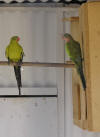. regent parrot

The Regent parrot is a member of the POLYTELIS genus along with the Princess parrot and Superb parrot. Aviary Notes: Level Of Knowledge Required: Beginner / Intermediate / Advanced / Specialist Breeders Only. Government Regulations & By-Laws: Refer to " Government Laws " web page. Housing Requirements: Refer to " Housing Birds " web page for general details on the housing of Australian Parrots or read on for specific details for this parrot. The Regent parrot can be housed in a wide variety of sizes of aviaries. 5 metre long aviary is recommended. Leafy branches or some type of screening is recommended at the open end of the aviary when the young leave the nest to help them avoid hitting the wire on their initial flights and injuring themselves. Will hybridize with other Polytelis birds such as the Princess parrot and Superb parrot. Non-toxic leafy branches, such as eucalypts, can be placed in the aviary for the birds to chew up. This will entertain the birds, help minimize boredom and give the birds some beak exercise. Natural branches of various diameters, and placed at various angles, can be used for perches. These natural perches may be chewed by the birds and may need to be replaced regularly. The birds may chew any flowers and fruiting bodies on the branches. Diet / Feeding: Refer to " Feeding Birds " web page for general details on the feeding of Australian Parrots or read on for specific details for this parrot. Good quality Budgie mix plus some sunflower seed. Sprouted or soaked seed if available. Only feed small quantities of sunflower seed. A variety of fruits such as apple and pear. A variety of vegetables such as corn and corn-on-the-cob and some green leafy vegetables such as silverbeet or endive. Dry commercial pellet feeds are becoming available and may form part of a balanced diet. Some birds will consume insects such as mealworms, especially around breeding season. Insects will provide the adult birds and young with a good source of easily digestible protein. Insects can be fed to these birds on a daily basis. Nesting: A basic overview only. Dimensions are typical / average and can vary widely, influenced by the owner's preferences and the birds preferences. Parent bird's preferences can also be influenced by the size and type of nest-box / log in which the bird was hatched and reared. If space allows, offering a choice of sizes and types of logs or nest-boxes, and placed in various locations within the aviary, can allow the parent birds to make their own choice. Once a pair has chosen a specific nest-box/log and been successful in it, offer that one to them each breeding season. Try and keep that one for their exclusive use. Once a pair has chosen its log or nest-box, the other ones can generally be removed. If the "spare" boxes are to be removed and moved to another flight, ensure the log / nest box is cleaned to ensure the receptacle has the minimal contamination of mites, parasites and pathogens. All Australian parrots will breed in hollow logs.
Generally tolerant of nest inspection.
More details on parrot nestboxes/logs and a selection of parrot nestbox/log photos can be found on the "nests", "parrot nests" and "parrot nestbox photos" web pages. Click on "Up" then "Nests" then "parrot nests" and "parrot nestbox photos" in the navigation bars. Breeding: Egg Colour White. Clutch/s per year 1. Eggs per nest 4 - 6. Incubation approx. 20 days. Fledge approx. 5 - 6 weeks. Independent approx. another 3 weeks. The hen is usually the dominant bird. Artificial incubation and hand rearing or fostering will not be covered on this web site. It is too complex and diverse in nature to be attempted here. Health Issues: Refer to "Avian Health Issues" web page for information and references.
General References: Refer to references listed on "Book References" web page. Specific References:
|